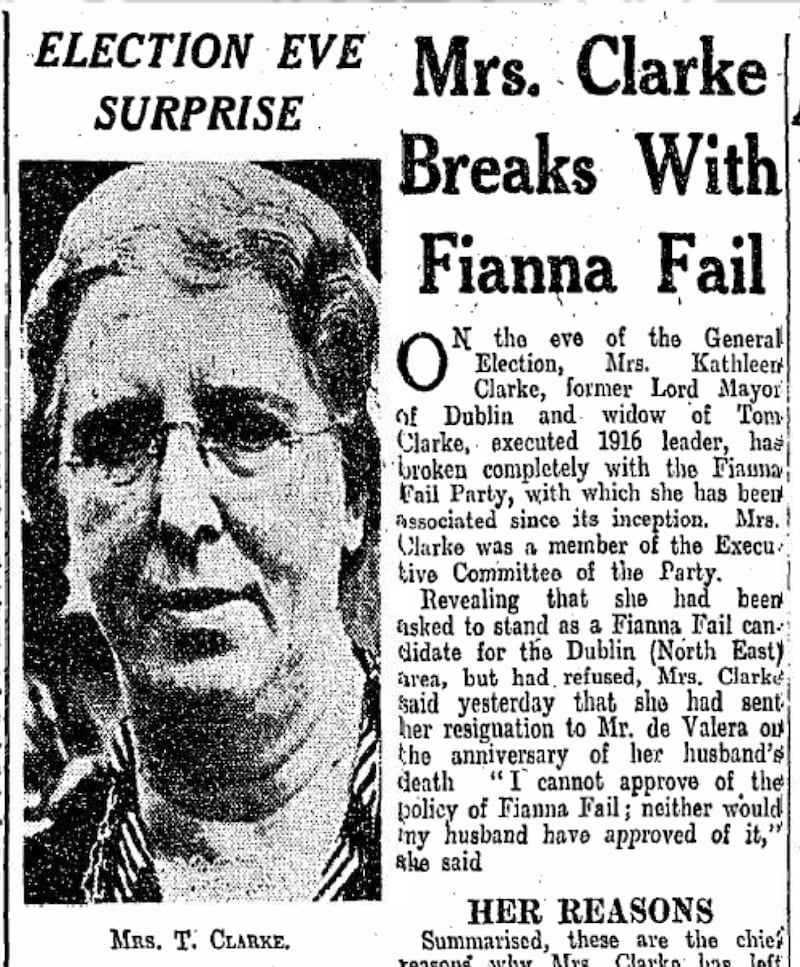In the Irishman’s Diary column published on Wednesday July 5th, 1939, the author mused over the newly elected Lord Mayor of Dublin, who was, for the first time, a woman. “I wonder how many of my readers are aware that our new Lord Mayor - or should it not be Lady Mayor? - is a duly appointed representative of the Admirality? Somehow, I should not be altogether surprised to hear that our Chief Magistrate herself has overlooked the fact that in addition to being a ‘Right Honourable’ she is ‘Admiral of the Port of Dublin’!… It would at least be interesting to know what view My Lords take on the innovation that - surely for the first time on record - shatters the sex traditions of Admiralty Arch!”
The author was having a bit of (in its time) fun with the novelty of a woman in office, but one wonders whether the new Lord Mayor, Kathleen Clarke, was amused. “No doubt we, the citizens of Dublin, will soon accustom ourselves to the queer paradox that - presumably for legal reasons - forbids a change in the title of Lord Mayor,” the column continued. “The compromise by which members of the gentler sex are addressed as ‘Madam Chairman’ is, to say the least of it, a rather clumsy expedient. But to the many visitors who will pay their respects this year at the Mansion House, the paradoxical designation of Mrs Clarke as ‘My Lord Mayor’, may prove to be really embarrassing.”
Four years later, a report on the front page of the newspaper on May 17th, 1943 declared that Clarke had split from Fianna Fáil. “On the eve of General Election, Mrs Kathleen Clarke, former Lord Mayor of Dublin and widow of Tom Clarke, executed 1916 leader, has broken completely with the Fianna Fáil Party, with which she has been associated since its inception.” Clarke had been asked to stand in the 1943 election in the Dublin North East area, but refused, and sent her resignation to Eamon de Valera on what was the 27th anniversary of her husband’s execution. “I cannot approve of the policy of Fianna Fáil,” Clarke said, “neither would my husband have approved of it.”
Clarke disagreed with Fianna Fáil on several matters, saying that the government had “taken the power out of the hands of the people”, claiming the party organisation “is controlled by the government”, that the government failed to reduce taxation and reorganise the civil service, that Fianna Fáil “has done nothing to do away with the Border”, and, Clarke believed “had abandoned its original policy towards the establishment of a Republic.”

Clarke also opposed “the method adopted towards the teaching of Irish in the schools,” a discussion that continues today. “She favours suggestions from experts as to the best means of fostering the language, and regards the atmosphere of compulsion in the schools as retarding process,” the report read. “The only question on which I can see eye to eye with the government is on the question of neutrality,” Clarke was quoted as saying at the time.
As Lord Mayor, Clarke moved into the Mansion House, but after she left, it was not lived in for some time. An article in July 1943 in this newspaper said that a new Lord Mayor of Dublin at that time, Alderman Martin O’Sullivan, had not yet moved in, “the house is always kept fully furnished and in readiness for a new occupant, except, of course, for linens and certain household utensils, which the occupants are expected to provide.”
In 1958, another woman was elected Lord Mayor of Dublin, Catherine Byrne of Fine Gael. At the time, the newspaper argued against how the party system operated in relation to the office of Lord Mayor. “It has, for example, been proposed that the candidates should be chosen on a strictly rotational basis: to adopt this proposal would merely serve to perpetuate the domination of civic affairs by national politics… The fact is that under the party system the citizens of Dublin are often denied their due - a Lord Mayor of their own choice who will bring to his high office the dignity, honour and courtesy which it demands. Dublin has had some outstanding mayors in recent years, but they have taken office in spite of, rather than as a result of, a system which is designed to put party first and city second.”
The title of the Mayor of Dublin was created in 1229, and became Lord Mayor in 1665. Before Clarke became the first female Lord Mayor of Dublin, the office was held 625 times, all by men. The office has been held 697 times in total, and by eight women. Kathleen Clarke, Catherine Byrne, Carmencita Hederman, Mary Freehill, Catherine Byrne, Eibhlin Byrne, Emer Costello and Críona Ní Dhálaigh. Were the council to attempt gender-balancing the office by installing only women Lord Mayors until that was achieved, it would take until the year 2709 for women to hold the office as often as men have.




















